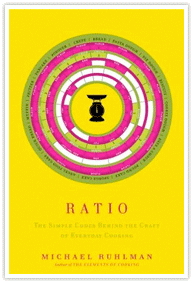My usual explanation of the difference between cooking and baking is a scientific one: Cooking uses methods, baking uses formulas.
But that’s too glib. It’s accurate in the sense that baking is much more sensitive to the amounts of ingredients — and the sequence in which they are added — than cooking is. Cook for long enough, however, and you find yourself able to start recipes based on fundamental combinations that pervade both cooking and baking. You learn that a roux starts with 3 parts flour and 2 parts fat. A pound cake has equal proportions of butter, sugar, eggs, and flour. A vinaigrette is 3 parts oil to 1 part vinegar. Cookie dough is 1 part sugar, 2 parts fat, and 3 parts flour.
What you’re doing is working with ratios. In The Making of a Chef, his excellent book about his experience as a student at the Culinary Institute of America, author Michael Ruhlman describes an interview with chef/administrator Uwe Hestnar:
He… turns to me with two sheets of paper. They contain a chart or grid covering a page and a half. This, he says, is all one truly needs. Here are the fundamentals of the culinary arts — all of Escoffier, Larousse, Câreme, as well as Julia Child, James Beard, The Joy of Cooking, and The Food Network — in their entirety, distilled to a page and a half. “I vould like to zell this for fifty dollars,” he says, “but no one vould buy.”
… I examine the sheets — a list of twenty-six items and their ratios. Along the top run the numbers 1, 2, 4, 6, 8, and 16. Along the side are rows divided by base products such as aspic, pâte à choux, sabayon, court boullion ordinaire. A primitive culinary spreadsheet.
Ruhlman, with Hestnar’s approval, expanded the basic spreadsheet and turned it into his latest book, Ratio (subtitled The Simple Codes Behind the Craft of Everyday Cooking).

The graphic on the front cover and the two pages following the table of contents are all you need, if you are to believe Ruhlman’s assertion that “cooking with ratios will unchain you from recipes and set you free.” All of the ratios are there, organized onto basic categories: doughs, batters, stocks and sauces, farçir, fat-based sauces, and custards. The realtiy is less simple, since the order of addition, temperature, and behavior of the components will determine the success of a ratio-based recipe.
The explanations account for the remaining 230 pages of the book. Ruhlman explains a basic recipe — pie dough, mayonnaise, sausage — then spins out a series of variations on the theme. The best example of his style and the structure of the book is the Doughs and Batters Ratio Chart, once again available for purchase.
I have a very good memory, but I know it’s not possible to keep all of these ratios in my head. I uploaded the chart to my iPhone, and will follow up with a retyped version of the ratios list from the front matter.
The true value of Ratio is how it has inspired me to experiment in the kitchen. I’ve already tossed out any remaining bottled salad dressing, preferring to whisk together my own (3 oil : 1 vinegar) a la minute. Family and friends will have to suffer through endless iterations of 1-2-3 cookies and 3-2-1 pie dough, but will ultimately benefit from my improved technique.
